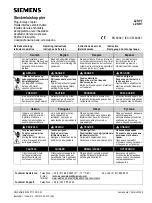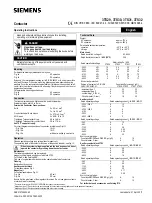
4.3
49 – Thermal Model
Thermal Protection and Alarm
The EMR-3MP0 provides a thermal model that is similar to Eaton's MP‑3000 motor relay to
approximate the thermal capacity used. The thermal model can work with or without the
Universal Resistance-Temperature Detector (URTD). The RTD-based direct temperature
trips and alarms are independent of the thermal model. Without the URTD, meaning the
URTD is not connected to the protective device or it is connected but not configured for
the thermal protection trips, the thermal model protection is based on the following
settings.
Settings for the maximum allowable thermal limit curve of the protected equipment:
• In menu [System Para]:
◦ »FLA« – Full Load Ampere – FLA = I
b
;
◦ »LRC« – Locked Rotor Current (LRC) – I
LR
;
◦ »LRTC« – Maximum Allowable Stall Time (LRTC) – T
LR
;
◦ »UTC« – Ultimate trip threshold current (usually equal to the Service Factor / SF,
that can be found on the motor nameplate or in the manufacturers data);
Settings for the thermal alarm curves relative to the thermal limit curve:
• In menu [Protection Para / 49]:
◦ »Alarm Threshold« – Thermal Model Alarm Threshold if enabled;
◦ »Alarm Delay«.
Thermal Capacity, Thermal Limit Curve
The effective heat current I
eff.heat
can be approximated by the equation:
I
eff.heat
² = I₁² + K₂ ⋅ I₂²
• I₁ = the per unit stator positive-sequence current;
• K₂ = weighting factor for the value of I₂ resulting from the disproportionate heating
caused by the negative sequence current component due to the skin effect in the
rotor bar.
The value of K₂ = 6.01 is internally fixed, so that the EMR-3MP0 mimics the thermal
model of Eaton's MP‑3000 and MP‑4000 motor relays.
• I₂ = per unit stator negative-sequence current.
With this, the thermal limit curve can be expressed as the following:
TripTime =
I
LR
2
⋅T
LR
I
eff.heat
2
154
www.eaton.com
EMR-3MP0
4 Protective Elements
4.3 49 – Thermal Model
















































